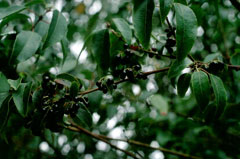 |
|
(c) 2010 Ken Fern & Plants For A Future |
 |
|
Translate this page:
Summary
Physical Characteristics

 Aristotelia chilensis is an evergreen Shrub growing to 3 m (9ft) by 5 m (16ft).
Aristotelia chilensis is an evergreen Shrub growing to 3 m (9ft) by 5 m (16ft).
See above for USDA hardiness. It is hardy to UK zone 8 and is frost tender. It is in leaf all year, in flower in May, and the seeds ripen from August to September. The species is dioecious (individual flowers are either male or female, but only one sex is to be found on any one plant so both male and female plants must be grown if seed is required). and is pollinated by Bees, insects. The plant is not self-fertile.
It is noted for attracting wildlife.
Suitable for: light (sandy), medium (loamy) and heavy (clay) soils and prefers well-drained soil. Suitable pH: mildly acid and neutral soils. It cannot grow in the shade. It prefers moist soil.
UK Hardiness Map
US Hardiness Map
Synonyms
A. macqui. Cornus chilensis
Plant Habitats
Woodland Garden Sunny Edge;
Edible Uses
Edible Parts: Fruit
Edible Uses:
Fruit - raw or dried for winter use[11, 22, 46, 61, 97]. A pleasant taste somewhat like bilberries[2]. The fruit is rather small, about 6mm in diameter[200].
References More on Edible Uses
Medicinal Uses
Plants For A Future can not take any responsibility for any adverse effects from the use of plants. Always seek advice from a professional before using a plant medicinally.
Astringent Febrifuge Poultice
A wine made from the fruit is said to have medicinal properties[11]. The plant (the exact part is not specified) is astringent, febrifuge and poultice. It is used in the treatment of throat infections and intestinal tumours[139].
References More on Medicinal Uses
The Bookshop: Edible Plant Books
Our Latest books on Perennial Plants For Food Forests and Permaculture Gardens in paperback or digital formats.

Edible Tropical Plants
Food Forest Plants for Hotter Conditions: 250+ Plants For Tropical Food Forests & Permaculture Gardens.
More

Edible Temperate Plants
Plants for Your Food Forest: 500 Plants for Temperate Food Forests & Permaculture Gardens.
More

More Books
PFAF have eight books available in paperback and digital formats. Browse the shop for more information.
Shop Now
Other Uses
References More on Other Uses
Cultivation details
Prefers a slightly acid, moderately fertile well-drained soil in full sun with shelter from cold drying winds[200]. Plants are fairly tolerant of maritime exposure[K]. This species is only hardy in the milder and moister areas of Britain[182] and even there can be cut back in severe winters[K]. If the plants are cut back by winter frosts, they normally put up a crowd of vigorous shoots in the spring and these will need thinning[219]. The fruits are freely produced in S.W. England[11]. There is a very good plant at Rosehill near Falmouth[59]. The flowers are very attractive to bees[59]. Dioecious. Male and female plants must be grown if seed is required[182].
References Carbon Farming Information and Carbon Sequestration Information
Temperature Converter
Type a value in the Celsius field to convert the value to Fahrenheit:
Fahrenheit:
The PFAF Bookshop
Plants For A Future have a number of books available in paperback and digital form. Book titles include Edible Plants, Edible Perennials, Edible Trees,Edible Shrubs, Woodland Gardening, and Temperate Food Forest Plants. Our new book is Food Forest Plants For Hotter Conditions (Tropical and Sub-Tropical).
Shop Now
Plant Propagation
Seed - sow spring in a greenhouse. When large enough to handle, prick the seedlings out into individual pots and grow them on in the greenhouse for at least their first winter. Once the plants are at least 20cm tall, plant them out into their permanent positions in late spring or early summer, after the last expected frosts. Consider giving them some protection from the cold for at least their first winter outdoors. Cuttings of half-ripe wood, July/August in a frame[11]. Cuttings of mature wood of the current season's growth in early winter[1]. Take cuttings 15 - 30cm long and plant them in pots or the open soil in a greenhouse. They normally root very easily and can be potted up in early summer then planted out late the following spring[K].
Other Names
If available other names are mentioned here
Clon, Koelon, Macqui,
Native Range
SOUTHERN AMERICA: Chile (Biobío, Coquimbo, Maule, Libertador General Bernardo O Higgins, Región Metropolitana de Santiago, Valparaíso, La Araucanía, Los Lagos)
Weed Potential
Right plant wrong place. We are currently updating this section.
Please note that a plant may be invasive in one area but may not in your area so it's worth checking.
Conservation Status
IUCN Red List of Threatened Plants Status :

Growth: S = slow M = medium F = fast. Soil: L = light (sandy) M = medium H = heavy (clay). pH: A = acid N = neutral B = basic (alkaline). Shade: F = full shade S = semi-shade N = no shade. Moisture: D = dry M = Moist We = wet Wa = water.
Now available:
Food Forest Plants for Mediterranean Conditions
350+ Perennial Plants For Mediterranean and Drier Food Forests and Permaculture Gardens.
[Paperback and eBook]
This is the third in Plants For A Future's series of plant guides for food forests tailored to
specific climate zones. Following volumes on temperate and tropical ecosystems, this book focuses
on species suited to Mediterranean conditions—regions with hot, dry summers and cool, wet winters,
often facing the added challenge of climate change.
Read More
Expert comment
Author
(Molina.)Stuntz.
Botanical References
11139200
Links / References
For a list of references used on this page please go here
Readers comment